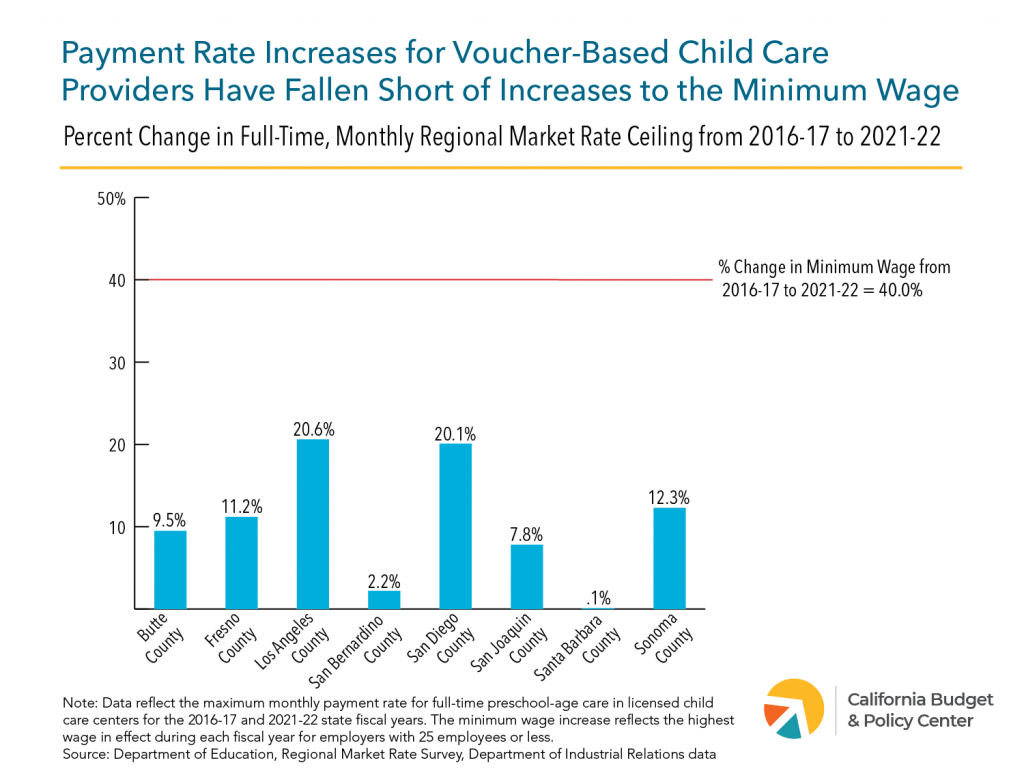Overdue for Pay Raise
State Payment Rates Are Not Keeping Pace with Rising Costs of Caring for Children, Wages, & Supplies
By: Erik Saucedo and Kristin Schumacher
Published: April 2022
California’s subsidized child care providers offer vital early learning and care for families struggling to make ends meet. Even as the COVID-19 pandemic continues, many providers and their staff have risked their health and safety to offer care for children of working parents.
These early educators — primarily women and disproportionately women of color — deserve to be paid professional wages for essential work that helps children learn and grow while parents are working to support their families.
Despite providers’ critical role in nurturing children and assisting families, state leaders have failed to consistently and adequately increase provider payment rates in recent years. Child care providers are unable to offer early educators adequate professional wages, struggle to keep pace with the rising statewide minimum wage, and can’t afford the increasing price of food and supplies if policymakers don’t provide routine and sufficient updates to payment rates.
Ultimately, California providers and families suffer when subsidized child care is limited in their communities because of policymakers’ lack of investment.
Providers and families suffer when subsidized child care is limited in their communities because of policymakers’ lack of investment.
How Are Subsidized Child Care Providers Paid in California?
Subsidized child care providers are paid in one of two ways in California: 1) by accepting vouchers from families or 2) by contracting directly with the state. Providers who accept vouchers are reimbursed by the state based on the Regional Market Rate (RMR) Survey. The RMR survey — administered every two to three years — provides “rate ceilings” based on provider setting and the age of the child for all 58 California counties.
The rate ceiling is the highest payment a provider can receive from the state for the care of a child. Providers that contract directly with the state are paid with a statewide rate called the Standard Reimbursement Rate, which has typically been adjusted for various factors such as the age of the child or disability status.
Payment Rates for Voucher-Based Child Care Providers Are Not Keeping Pace Across 58 Counties
California experienced strong revenue growth over the past five years, yet state leaders updated voucher-based payment rates for child care providers just twice since the 2016-17 state fiscal year.
During this same period, the state law requiring annual increases to the statewide minimum wage went into effect, raising the wage by 40% from 2017 to 2022.
The rate ceilings for child care providers across all 58 counties generally have not kept pace with the rising minimum wage even after the most recent increase to payment rates included in the 2021-22 state budget agreement. In the state’s two most populous counties — Los Angeles and San Diego — payment rates for licensed centers caring for preschool-age children increased by half as much as the statewide minimum wage. Providers in some counties, such as Santa Barbara County, saw miniscule rate increases of less than 1%. And in 27 counties, due to weaknesses in the rate-setting methodology, licensed centers have not received a single rate increase for care for preschool-age children since the 2016-17 state fiscal year.

State Rate for Contract Providers Doesn’t Match Rising Child Care Business Costs
Similar to voucher-based payment rates, policymakers also have not consistently updated the Standard Reimbursement Rate each year so that contract providers keep pace with rising staff costs and the increasing price of food and supplies.
From 2016-17 to 2021-22, the Standard Reimbursement Rate has increased by just 28.2%, falling short of the 40% increase in the state minimum wage.

Even though contract-based providers are required to meet more program standards than voucher-based providers do, the payment rate is lower than the Regional Market Rate ceiling in many counties, illustrating a key problem with the state’s bifurcated rate system. To correct for this, policymakers included a provision in the 2021-22 budget agreement to reimburse contract-based providers with either the Standard Reimbursement Rate or the rate for voucher-based providers, whichever is higher.
Subsidized Child Care Providers Urgently Need a Pay Raise
Already operating on thin financial margins, child care providers have struggled during the pandemic with a loss of income and increased costs due to reduced enrollment, temporary closures, and enhanced health and safety requirements.
Policymakers’ recent efforts to boost subsidized child care providers’ payment rates and to provide other one-time rate supplements are just the first step to fair and just payment rates. In addition to increasing payment rates, the 2021-22 budget agreement also required the governor’s administration and providers, parents, and other early childhood experts to begin work on a plan to replace the state’s bifurcated rate system with a unified, equitable system.6
But subsidized child care providers and the families they serve can’t wait. While a permanent solution is in the works, state leaders should provide another payment rate increase in the 2022-23 budget agreement to ensure child care providers can keep up with rising costs while continuing to offer invaluable care to children and families.
